- 1-905-452-8193
- Contact Us
- Member Login
- Get Listed Today
- 220,911 members

Fall is the time of year when we start to think about preparing our homes for the cold winter months ahead. But did you know that spring is also an important time to give your home a thorough cleaning? This is especially true for your air conditioning Sydney system, which can become clogged with dust and debris over the winter. A little spring cleaning on your HVAC will help keep your system running smoothly all summer long.
To help you out, here is a handy HVAC spring cleaning checklist. This simple guide covers all the basics, from checking and changing your air filter to scheduling a professional inspection and tune-up. So print it out and get started on keeping your HVAC system in tip top shape!
Start with a visual inspection.
First, take a look at your HVAC unit and make sure there is no visible damage or debris around it. If you see any leaves or other debris caught in the fan blades, remove them carefully.
Clean the air filter.
The air filter is one of the most important parts of your air conditioner, and it should be cleaned or replaced on a regular basis. Check your owner’s manual to see how often you should be doing this.
Vacuum the coils.
The coils in your HVAC unit can become clogged with dust and debris, which can make the unit work harder than it needs to. Use a vacuum attachment to clean the coils thoroughly.
Clean the condensate drain line.
The condensate drain line helps remove water from your air conditioner, and it can become clogged over time. Pour a cup of bleach down the line once a month to keep it clear.
Dust the registers.
The registers in your home can become dusty, which can impact the air quality in your home. Use a damp cloth to dust them off on a regular basis.
Clean the outside unit.
The outside unit of your HVAC system should be cleaned on a regular basis as well. Use a hose to remove any leaves or other debris that has accumulated around it.
Trim back any vegetation.
If there are any trees or bushes near your air conditioner, make sure they are trimmed back so they don’t impede airflow.
Check for leaks.
Make sure there are no water leaks around your HVAC unit. If you see any, repair them as soon as possible.
Inspect the ductwork.
The ductwork in your home can become clogged with dust and debris over time. Have it cleaned by a professional every few years to ensure optimal airflow.
Seal any gaps or cracks.
Take a look around your home and make sure there are no gaps or cracks around doors or windows that could let in outside air. Use caulk or weather-stripping to seal them up.
Insulate the ductwork.
If your home has uninsulated ductwork, now is the time to add some insulation. This will help keep the air inside your home cool in the summer and warm in the winter.
Change the direction of your ceiling fans.
In the winter, your ceiling fans should be spinning clockwise to push the warm air down. In the summer, they should be spinning counterclockwise to create a cooling breeze.
Get a tune-up.
Schedule a professional tune-up for your air conditioner system to make sure it is running properly and to catch any potential problems before they become serious.
Invest in a programmable thermostat.
A programmable thermostat can help you save money on your energy bills by allowing you to set different temperatures for different times of the day.
By following these simple tips, you can help ensure that your HVAC system is ready to keep you comfortable all spring and summer long. If you need more information or professional advice, get in touch with a reputable technician as soon as possible. These people have the equipment and skills to safely complete any maintenance project.
